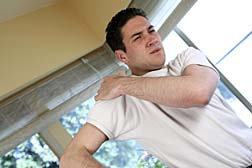A study published in The American Journal of Sports Medicine (July 3, 2007), linked shoulder pain pumps to Postarthroscopic Glenohumeral Chondrolysis (PAGCL). The study authors noted that, "Use of intra-articular pain pump catheters eluting bupivacaine with epinephrine appear highly associated with postarthroscopic glenohumeral chondrolysis." The authors found that of 19 patients who used the pain pumps, 12 were diagnosed with PAGCL.
 Furthermore, a paper presented at a 2006 meeting of the American Academy of Orthopedic surgeons showed that of 152 patients who underwent arthroscopic surgery, 12 developed PAGCL. All 12 patients who developed PAGCL after the surgery also had a pain pump during their surgeries. In fact, use of the pain pump was the only factor that all patients had in common.
Furthermore, a paper presented at a 2006 meeting of the American Academy of Orthopedic surgeons showed that of 152 patients who underwent arthroscopic surgery, 12 developed PAGCL. All 12 patients who developed PAGCL after the surgery also had a pain pump during their surgeries. In fact, use of the pain pump was the only factor that all patients had in common.Postarthroscopic Glenohumeral Chondrolysis actually means a break down of the cartilage in the glenohumeral joint (the shoulder joint) following arthroscopy. Essentially, the cartilage in the patient's shoulder deteriorates, causing pain and stiffness. In some cases, the patient loses the ability to use the shoulder.
During arthroscopic surgery, the doctor uses a tiny camera and two small incisions to repair injury to the patient's shoulder. However, shoulder arthroscopy can be somewhat painful, requiring pain medication to help patients cope. Some patients are given a pain pump that usually contains bupivacaine and may have epinephrine pumped directly into the shoulder joint. Researchers speculate that PAGCL is caused because a high concentration of pain medication is pumped directly into the surgery site.
The problem for patients with PAGCL is essentially the requirement of cartilage for movement of the glenohumeral joint, which is made of a ball at the end of the arm bond that fits into the socket of the shoulder blade. Cartilage covering the ball of the arm bone allows the shoulder joint to move smoothly and painlessly. When the cartilage breaks down, the shoulder no longer moves smoothly, resulting in pain, stiffness, and reduced range of motion.
Symptoms of PAGCL include:
• Pain when the shoulder is in motion and/or at rest
• Clicking, popping and/or grinding,
• Weakness or stiffness in the shoulder, and
• Decreased range of motion.
READ MORE LEGAL NEWS
Anyone who has had shoulder arthroscopy and used a pain pump can develop PAGCL. Level of health does not predict who will develop it. Based on the link between pain pumps and PAGCL, some researchers, including those who wrote the study in The American Journal of Sports Medicine, have recommended that patients use oral pain medications only in regulating their pain after shoulder arthroscopy.
